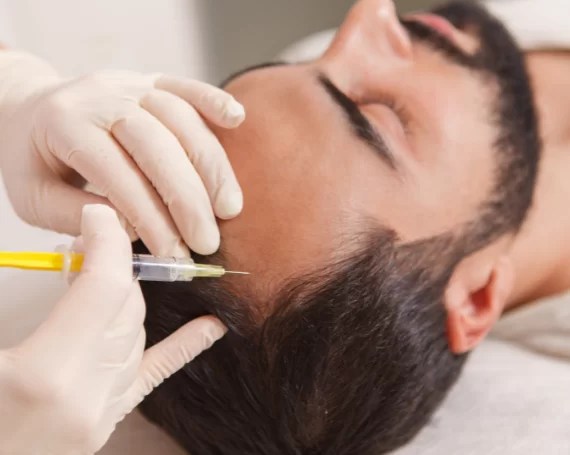Unlock Thicker Hair with PRP Hair Therapy

Hair loss is a concern for many, impacting self-esteem and confidence. While there are numerous treatments available, PRP In Dubai hair therapy stands out as a promising option for those seeking to restore and enhance their hair's thickness. This article explores the benefits, procedures, and considerations of PRP hair therapy, offering insights into how it can help unlock thicker, healthier hair.
Understanding PRP Hair Therapy
PRP hair therapy is a non-surgical treatment designed to stimulate hair growth and improve hair density. It utilizes the body's own platelets to rejuvenate hair follicles, promoting natural hair regeneration. The therapy involves drawing a small amount of the patient’s blood, processing it to concentrate the platelets, and then injecting this enriched plasma into the scalp.
How PRP Hair Therapy Works
- Blood Collection: The process begins with a simple blood draw, typically from the arm. This blood is then placed in a centrifuge, which spins it at high speeds to separate its components. The result is a concentrated solution rich in platelets, known as Platelet-Rich Plasma.
- Preparation of PRP: The separated plasma is prepared for injection. It contains growth factors and proteins that are crucial for cell repair and regeneration. This concentration of platelets is what makes PRP therapy effective for hair restoration.
- Injection into the Scalp: The PRP is then injected into the scalp at specific locations where hair thinning or loss is noticeable. The growth factors in the PRP stimulate the hair follicles, encouraging them to enter the active growth phase and produce thicker hair.
Benefits of PRP Hair Therapy
- Natural and Safe: One of the major advantages of PRP therapy is that it uses the patient’s own blood, reducing the risk of allergic reactions or complications. The procedure is minimally invasive and avoids the need for synthetic substances.
- Effective for Various Types of Hair Loss: PRP therapy can be beneficial for different types of hair loss, including androgenetic alopecia (pattern baldness) and alopecia areata. It is suitable for both men and women seeking to improve hair density.
- Stimulates Hair Growth: The growth factors in PRP promote the health of hair follicles, encouraging dormant follicles to become active. This can lead to increased hair thickness and volume over time.
- Improves Hair Quality: In addition to stimulating new hair growth, PRP therapy can enhance the quality of existing hair, making it stronger and more resilient.
- Minimal Downtime: Patients can typically resume their normal activities immediately after the procedure. There might be slight redness or tenderness at the injection sites, but these effects are generally short-lived.
What to Expect During and After the Procedure
During the Procedure: PRP hair therapy is performed in a clinical setting, often within an hour or two. The area of the scalp to be treated is usually numbed with a local anesthetic to minimize discomfort. Patients may feel a slight prickling sensation during the injections, but the procedure is generally well-tolerated.
Post-Procedure Care: After the treatment, patients are advised to avoid washing their hair for at least 24 hours to allow the PRP to settle into the scalp. It is also recommended to avoid direct sun exposure and strenuous activities for a few days. Following these guidelines can help ensure optimal results.
Results and Maintenance: Initial results can typically be seen within a few months, with significant improvements becoming more apparent around six months after treatment. To maintain the results, patients may need to undergo several sessions, usually spaced about four to six weeks apart. Regular follow-ups with a healthcare provider can help monitor progress and determine the need for additional treatments.
Factors to Consider
- Consultation and Assessment: Before starting PRP therapy, a thorough consultation with a healthcare professional is essential. This assessment helps determine if PRP is a suitable treatment based on individual hair loss patterns and overall health.
- Expectations: While PRP therapy can significantly improve hair density and quality, it is important to have realistic expectations. Results can vary, and the therapy may not work for everyone. It is best suited for individuals who still have active hair follicles and are seeking to enhance their hair growth.
- Cost and Commitment: PRP therapy requires a commitment to multiple sessions and may involve a financial investment. Understanding the treatment plan and discussing potential costs with a healthcare provider can help in making an informed decision.
- Choosing a Provider: Selecting a qualified and experienced provider is crucial for achieving the best results. Researching and consulting with professionals who specialize in PRP hair therapy can ensure that the procedure is performed safely and effectively.
Conclusion
PRP hair therapy offers a promising solution for those looking to unlock thicker, healthier hair. By leveraging the body's natural healing mechanisms, this innovative treatment stimulates hair growth and improves hair quality with minimal invasiveness. Understanding the procedure, benefits, and considerations can help individuals make informed choices and achieve their hair restoration goals. With the right approach and expectations, PRP therapy can be a valuable tool in the journey toward fuller, more vibrant hair.